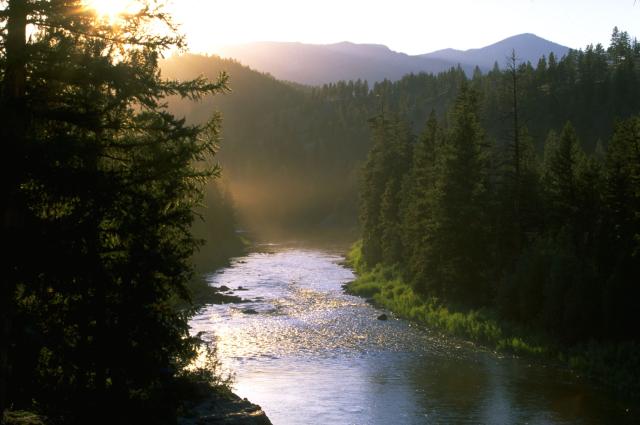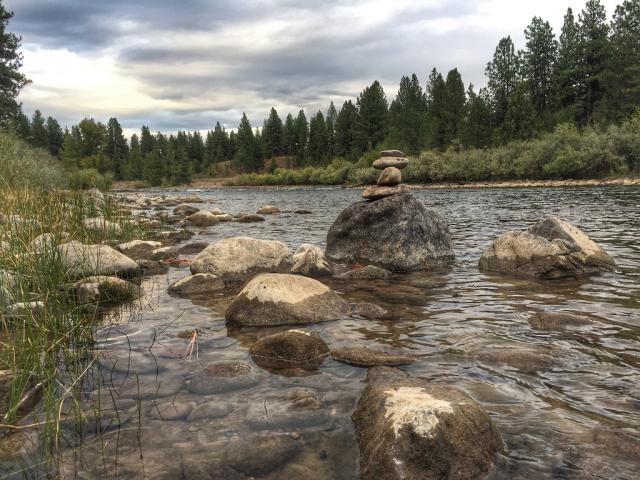You are viewing ARCHIVED content published online before January 20, 2025. Please note that this content is NOT UPDATED, and links may not work. Additionally, any previously issued diversity, equity, inclusion or gender-related guidance on this webpage should be considered rescinded. For current information, visit https://www.blm.gov/blog.
Partnering to Steward Recreation Opportunities on the Blackfoot River
The Blackfoot River starts its journey at the top of the Continental Divide at the southern end of the Crown of the Continent ecosystem. The river flows downward 3,000 feet through wilderness areas, managed forests, and private lands making its way towards Missoula, Montana. Along the way, it is joined by the North Fork of the Blackfoot and Clearwater rivers and other tributaries as it makes a 132-mile journey to its confluence with the Clark Fork River. The river provides important fish and wildlife habitat, supports agricultural operations, and provides recreation opportunities to locals and visitors alike.

The Blackfoot Challenge was established in 1993 to formalize the efforts of landowners and other partners that had been working together since the 1970s to conserve and enhance the natural resources and rural way of life in the Blackfoot watershed. For more than three decades, The Blackfoot Challenge, land managers, and other partners have worked together to ensure that the river, and the communities it supports, get the attention they deserve.
Seth Wilson, Executive Director of the Blackfoot Challenge, sees the organization as the “catalyst and convener of respectful, thoughtful civil conversations and discussions about how we steward and conserve this beautiful watershed.” The Challenge takes a ridge-to-ridge approach to understanding the watershed and anchors the community's needs in their decision-making processes. Such an approach recognizes that the lands, resources, and people in the watershed are connected.
Community members and businesses being impacted by the droughts that have plagued the watershed in recent decades came together to collaboratively develop and launch a Drought Response Program. They have also worked on water management, water quality, restoration, and land conservation. The Blackfoot Challenge is now turning its gaze toward the impacts that recreation has on the river.

Growing Pains on the Blackfoot
Over the years, the Blackfoot watershed has faced many pressures and challenges. “There is a history of intense resource extraction. There has been historic mining in the headwaters that led to pollution and heavy metal contamination. There was large-scale timber extraction. By the late 1800s there was cattle ranching that wasn't as sustainable as it is today,” said Wilson.
While mining and logging are no longer as prevalent along the Blackfoot and its tributaries, recreational use has increased immensely in recent years, putting a strain on the river. "During the COVID pandemic, we saw a huge surge in recreation pressure on the river,” shared Clancy Jandreau, Blackfoot Challenge’s Water Steward. As we turn the corner with the pandemic, Jandreau has not seen the pressure letting up.
On the Blackfoot, access points have become overrun with recreationalists hoping to get on the water. When designated parking runs out, people create their own parking spots. Busy parking lots often come with more conflicts on boat ramps and the river, user-created trails, and trash.
Claire Romanko, a restoration specialist with the Bureau of Land Management (BLM) Field Office in Missoula noted that “There are fishing access sites that are called ‘three-stalls’ because they can only accommodate three cars. Today, there might be six to eight cars parked on the side of the road next to the three-stall. When people see that they can park in undesignated parking areas, it creates a sprawling effect, and access points were never designed to handle the amount of use we see today.”
To alleviate the growing pains associated with recreation, the Blackfoot Challenge and the team of partners they have assembled is being thoughtful about the future of recreation on the river. “If we're truly responding to our community and what our community’s concerns are, we have to make sure we do that genuinely,” Wilson commented. “We're in a listening phase of going out and developing a better understanding of what our community is concerned about with recreation. That will give us a chance to craft solutions that are meaningful to community members.”
One thing the Blackfoot Challenge understands is that some recreation concerns are due to a lack of understanding by users, and not a willful lack of compliance. With that in mind, Jandreau is increasing education on how to be a responsible and respectful river user and exploring the idea of launching a river ambassador program in the Blackfoot.
The River Ambassador Program would train staff or community members who want to volunteer their time to be present at highly trafficked river access points. River ambassadors would serve as a source of information and education for river users, help answer questions, and support people accessing the river smoothly. Jandreau envisions ambassadors suggesting alternative access points that may be less busy, relaying information about hazards they may experience on the river, providing tips and tricks on user etiquette and behavior, and serving as additional eyes and ears for land and recreation managers.
As river pressures continue to build, BLM and the Blackfoot Challenge are excited to work together to explore how a river ambassador program might alleviate some of that stress. The Blackfoot Challenge is monitoring the river to collect data to help gain a baseline understanding of recreation uses, including when and how river access points are being used. Romanko remarks, “We often hear anecdotally that the river is crowded, but we need to home in on specific locations where we can concentrate resources in the future to reduce the user conflict issues we are seeing.” This partnership with The Blackfoot Challenge is the first step towards launching a community-led Blackfoot River Ambassador Program that includes investment from the Blackfoot Challenge, BLM, and Montana Fish, Wildlife & Parks.
Rose Vejvoda, Intern
Related Stories
- Aerial sagebrush seeding helps restore Robertson Draw Fire burn area
- BLM recreation sites available to all: Exploring accessibility on California’s public lands
- BLM recreation sites available to all: Exploring accessibility on Arizona’s public lands
- Steer clear of muddy roads and trails this spring
- BLM Recreation Sites Available to All: Exploring Accessibility on Alaska’s Public Lands
